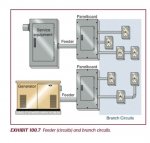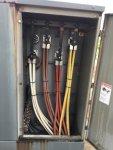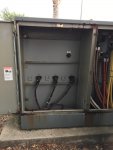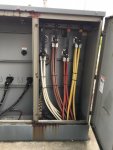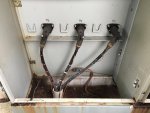Shujinko
Senior Member
I am designing a project where the client has an existing stand alone building (metal shed) for a stand-by generator that basically backs up the entire campus loop if the utility power goes out. The generator is rated at 480Y/277 and the voltage is stepped up outside of the building to 12470Y/7200V to feed acampus loop. We aren't doing any work on the Medium Voltage side only the Low Voltage Side (480Y/277V) in the metal shed building.
In the building the client is upgrading from (1) 1400KW diesel generator with an ATS to having (3) 500KW diesel generators paralleled with a paralleling switchboard. The neutral and ground will be bonded in the paralleling switchboard and the generator breakers are all in the paralleling switchboard, no breakers at the generators.
If this is the case, would I have to comply with NEC 230.6 and concrete encase the portion of the feeders from the generators to the paralleling switchboard since they will be installed over head (above grade) and system won't be grounded until it reaches the paralleling switchboard?
In the building the client is upgrading from (1) 1400KW diesel generator with an ATS to having (3) 500KW diesel generators paralleled with a paralleling switchboard. The neutral and ground will be bonded in the paralleling switchboard and the generator breakers are all in the paralleling switchboard, no breakers at the generators.
If this is the case, would I have to comply with NEC 230.6 and concrete encase the portion of the feeders from the generators to the paralleling switchboard since they will be installed over head (above grade) and system won't be grounded until it reaches the paralleling switchboard?


